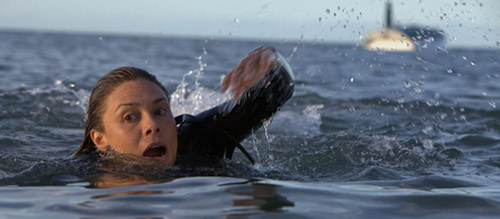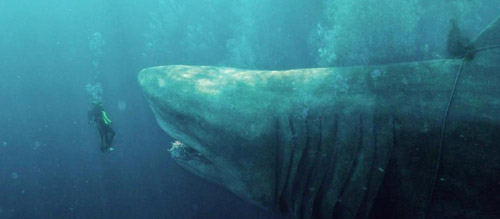Why Is It So Hard to Make a Good Shark Film?
Why is it so hard to make a good shark film? We know it’s possible because one of the greatest films ever made is a shark film.
Jaws (1975)
Jaws celebrated its 45th birthday in June. In those 45 years it has become a global phenomenon. It sparked mass fear of actually quite placid creatures, and is still shown in cinemas around the world. Critically acclaimed and publicly revered. Rightly so, it is iconic moment after iconic moment. And with two deaths under Bruce’s belt, and a pier ripped in half before the viewer even sees the shark, it’s a masterclass in suspense. A deeper dive into the film’s history reveals that this was Spielberg’s creative way around a mechanical shark that kept breaking down. The dorsal fin slicing, then ducking under the water is as terrifying as any axe-wielding movie maniac. The film also holds the rare accolade of being much better than the book it’s adapted from. Weeding out the dinner party waffle and needless affairs and stripping it down to a hungry fish, three men and a boat. By simplifying the relationships and making the characters a whole lot more likeable, Gottlieb and Benchley made the shark the sole obstacle to overcome. The film makes the shark bigger, more dangerous, more legendary. For some reason this has been an impossible achievement to replicate. Whether it is because audiences willing to watch shark films aren’t considered discerning, or because filmmakers are trying too hard to make their films so drastically different from Jaws, they are missing every single mark. Because, as it turns out, even though you can make a shark film, it doesn’t mean you should.
It is fair to say that most shark films are mediocre, and others are just plain bad. Merely an excuse to clad some women in bikinis and make them scream. When Bait, a romp in a tsunami-struck supermarket with a shark in every aisle, is among the more enjoyable watches, it’s fair to say the competition is poor. When the premise is so simple – a cool and illusive animal, that happens to also be one of the most effective killers the planet has ever known, is loose in a body of water so big nobody can find it to stop it – it is hard to understand how so many get it wrong.
How can a film about a shark be boring? So many of them are. Either too full of complicated subplots eating into valuable screen time with the subaquatic anti-hero, detracting from the real issue at hand: the really massive Great White just under the boat. Or, too simple: literally a handful of characters floating in an inexplicably calm sea for 90 minutes, slowly being picked off until the last panting survivor hauls themselves up onto a rock. It’s hard to maintain suspense when waiting for the next attack is literally all the viewer is doing. The narrative of Jaws is complicated, sure, but it is perfect. The original bromance, anti-capitalist sentiment, man vs nature thematic exploration. But with Matt Hooper providing balance with a reverential view of the fish. It needs to be slaughtered but he’s going to be respected.
The Reef (2010)
There is a fine line between too many killings, where the viewer becomes jaded and immune to shock, and a film so lacking in jeopardy it’s easy to forget there’s even supposed to be a shark in it. The Reef (whose director Andrew Traucki is also responsible for slow moving Croc thriller Black Water) and Open Water – a film with stylistic choices that make it look like an 80s episode of ‘Neighbours’ yet was unfathomably the more successful of the two – are prime examples of the latter. If watching The Reef immediately after Jaws, chances are it will come out poorly. Watch it after a failed attempt to get through Sharknado and it’s actually a tight thriller with slick sharks and reasonable acting.
As for complicated subplots the list is endless, the aforementioned Bait sees sharks in a supermarket, a bungled burglary, a cop, a wayward daughter, ex-lovers, current lovers, an it-girl and a geek. Set in Seaworld, Jaws 3 has it all, brewing romance, a mother shark out for revenge, meddling dolphins, and jet skis. The Meg is crammed with pseudo-science, a six-year-old to protect, treacherous CEOs, clashing personalities, a dark past, an ex-girlfriend, a new girlfriend. Megalodon sees a military coup and Russian spies combat a prehistoric monster. 47 Metres Down: Uncaged makes blind sharks the adversary of rival siblings, set in an ancient underwater city. Surrounded tries to build a shark tale out of thrill-seeking, romantically entangled influencers, each more unlikeable than the last. Jaws 4 muddles together a psychic shark, a trip to the Bahamas, another child to protect, and a romance with Michael Caine no less. And Deep Blue Sea uses sharks to cure Alzheimer’s, alcoholic preachers who are also chefs, corporate funders admitting to murder, existing relationships, and potential new ones. It’s exhausting just listing this stuff, let alone writing it or watching it. The crux is, most sharksploitation (yes that is a term) films rely heavily on stupid characters making stupid decisions. Those that don’t stand out. Brody, Hooper and Quint are so removed from that trope they are practically MENSA.
If anything, these newer ventures into the genre should have had it easy. Jaws laid so much of the groundwork. The first film whipped up such a palpable and frenzied fear that any subsequent film should have had an easy voyage. Obviously not. Even Jaws 2, released just three years after the first, in the midst of fresh foamy hype, doesn’t manage to reach anywhere near the dizzy high notes of its predecessor. Still centring around Brody and his family, the film relies too heavily on fans still loving those characters. The shark is much more evident on screen, contradicting precisely the genius of Spielberg’s decision to hide the beast first-time round. It’s a paint by numbers shark film, by no means the worst, but lacking the tension, the conflict and the suspense of a truly successful thriller, as well as the warmth, the humour and the high stakes of a truly great film. By killing 6-year-old Alex Kitner so early on, Jaws sets its stakes the highest. The grief at losing a child is more terrifying than any shark. Brody is set up to do his magic. The third and fourth films in the franchise are truly terrible and it is easy to spend longer reading about why these films were made, rather than actually paying attention to them.
The Meg (2018)
It is impossible to discuss any killer animal movie without looking at the effects, and the effects in nearly all these films are laughable. It’s not just the creatures, Jaws 3 has a prop corpse so fetid it borders on criminal. Bad CGI and broken-down animatronics are as much the star of the show as Tara Reid or LL Cool J. Where Spielberg used the unreliability of his machine to create something amazing, every other filmmaker seems to have just ploughed on with mediocrity. The Meg is a laughably bad film, but the graphics are at least good. It’s hard to expect anything less with a budget of £178 million though. It is hard to understand why people continue to make them if decent effects can’t be achieved. Are all potential shark directors simply happy with B-Movie status? Are audiences? Is anything too realistic going to be too scary? The films with the most realistic sharks (The Meg aside) seem to be those with the simplest stories: Open Water, The Reef, Dark Tide. Real sharks are going to look real on screen. It’s a shame their stories don’t carry any weight. Dark Tide holds the rare accolade of 0% on Rotten Tomatoes. Not even deemed So Bad It’s Good like many other cult shark ventures (think Sharknado, House Shark, Deep Blue Sea). At least no sharks, mechanical or otherwise, were harmed in the making of.
Bad acting helps feeds the myth that there is no such thing as a decent shark film. Jaws and Deep Blue Sea have proper thespian clout. Same for The Shallows and The Meg. True, Jason Statham isn’t going to win an Oscar, but people have heard of him. Continuity errors, lazy editing, ill-conceived characters and clichés all fuel this sub-genre of horror. Audiences don’t forgive it in a regular horror. Why is it acceptable when an animalistic attack is involved? Why should sharks take the rap for a filmmaker’s failings?
All films that fall into the natural horror category, whether they be sharks, crocodiles, snakes or spiders, are ultimately about one thing: man’s need to conquer. To beat nature at its own game. To control the uncontrollable. Those that choose the shark to win don’t feed that primal desire in an audience. Those that champion their humans risk coming across as sanctimonious or, as our relationship and understanding of the natural world changes, needlessly destructive. Did that super intelligent shark really need a crucifix in its eye?
Maybe there are just too many jigsaw pieces that need to slot exactly into place required to make a successful shark film? Or maybe you just need Richard Dreyfuss.
Written by Martha Lane
You can support Martha Lane in the following place:
Twitter – @poor_and_clean





It isn’t rocket science. What scares people about sharks? It’s not sharks attacking battleships, or people shipwrecked in the ocean. It’s sharks attacking people near the beach. Get a good script, decent actors and for the love of god stop with the bad cgi. Next make it hit home for people who visit the ocean.